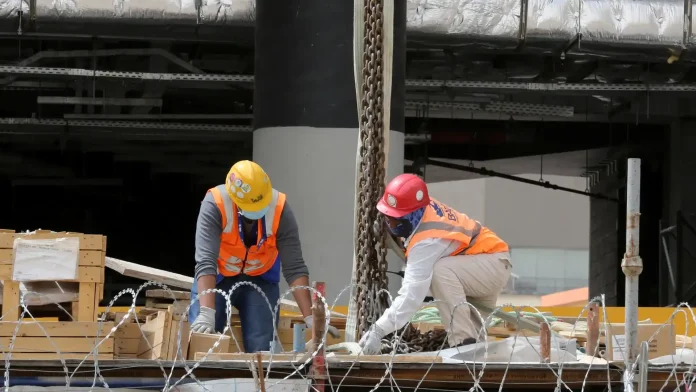The Goat Life is a film that tells a story of unimaginable suffering and survival of the life of an Indian migrant worker Najeeb. He finds himself at the mercy of a cruel and exploitative establishment in Saudi Arabia. The film’s narrative full of struggles, abuse, and dehumanization offers a glimpse into the real-life stories of many migrants in the area. In this blog, we will reveal how The Goat Life serves as a stark reflection of the struggles of the exploitation of migrant workers in Saudi Arabia, highlighting themes of exploitation, powerlessness, and loss of identity.
Vulnerability of New Entrants
Najeeb’s journey in The Goat Life begins with his arrival in Saudi Arabia, where he is immediately confronted with the experience of powerlessness. Unable to understand the language and unable to find his sponsor, Nejeeb quickly realizes that he is alone in a strange land. This sense of vulnerability is common to many migrant workers who arrive in Saudi Arabia regularly without any knowledge of the language, subculture, or legal establishment.
This vulnerability allows newcomers smooth targets for exploitation. Many migrants like Najeeb come with the desire to find better options, most simply to find themselves abandoned by the people who were meant to lead them. This abandonment leaves them at the mercy of others who will not care about their quality hobbies. Najeeb’s disorientation at the airport is a powerful representation of the disempowerment felt by many workers and sets the stage for the exploitation that follows.
The Cycle of Exploitation
The film accelerates the action from disorientation to exploitation as Najeeb suffers fraud and sooner or later finds himself in the hands of a “fake sponsor”. This sponsor incites him to brutal treatment and forces Najeeb to embark on a journey along a desolate road that symbolizes the harsh reality many migrants face. The cycle of exploitation experienced by Najeeb is not all that unusual for employees who are tricked through the use of false promises and become trapped in abusive situations.
In Saudi Arabia, the kafala facility that connects people with their sponsors often creates situations in which exploitation can flourish. Additionally, employees may find themselves working long hours for low pay without having to escape their situation. The faux sponsor in the film represents the darker side of this system where power is abused and employees are treated as little more than commodities. Najeeb’s experience mirrors the real-life struggles of many migrant workers who find themselves trapped in a cycle of exploitation with no way out.
Helplessness and Abuse
One of the most disturbing elements of The Goat’s Life is Najeeb’s complete helplessness in the face of abuse by his sponsor. The sponsor controls every aspect of Najeeb’s existence, from when he can eat and drink to how he is treated. This helplessness is a key theme of the film, reflecting the reality of many migrant workers who are at the mercy of their employers.
In Saudi Arabia, the kafala facility provides employers with considerable control over their employees, regularly especially under conditions where unchecked abuse can occur. Workers may be subjected to physical and psychological abuse without the ability to escape or seek help. Najeeb’s treatment at the hands of his sponsor is a powerful reminder of the dangers of this facility, in which power imbalances can lead to excessive abuse. The film highlights the urgent need for reforms to protect workers and ensure they are no longer subjected to such redress.
Loss of Identity and Humanity
As the film progresses, Najeeb changes, both physical and mental. He loses weight and grows a beard and his pores and skin treatments shade due to the harsh conditions he endures. Eventually, he begins to live like the goats he cares for, dropping the ability to speak and adopting goat-like behaviour. This transformation is an effective metaphor for the loss of identity and humanity experienced by many migrant workers exposed to extreme conditions.
The film’s depiction of Najeeb’s descent into a goat-like existence highlights the dehumanization that can occur when employees are treated as mere tools rather than people. The lack of identification and humanity is an unfortunate consequence of the exploitation and abuse of many employees. Najeeb’s transformation is a stark reminder of the preference to treat all people with dignity and respect and to ensure that their basic human rights are recognized.
Urgent Need for Replacement
A Goat’s Life is more than just a movie; it is a challenge to move over miles. The film’s portrait of Najeeb’s struggle serves as a stark reminder of the urgent need for exchange to protect the rights of migrant workers. The kafala establishment, which enables exploitation and abuse, is desperate for reform to ensure that people are treated with the dignity and recognition they deserve.
The film encourages us to crack down on the systems that allow such abuses and to stand up for workers’ rights. It is a reminder that at the end of every story of exploitation, there is a man or woman who deserves dignity and admiration. The film urges us to do so to protect workers’ rights and ensure that no one is subjected to the form of struggle that Najeeb endured.
The Goat Life offers a haunting depiction of the struggles faced by migrant workers in Saudi Arabia. Through Najeeb’s story, the film highlights the vulnerability, exploitation, and lack of identification faced by many workers. It serves as an effective reminder of the need for systemic change to protect the rights and dignity of migrant workers. The film challenges us to do just that, stand up for the rights of queer people and ensure that everybody is treated with the honor and dignity it deserves.













